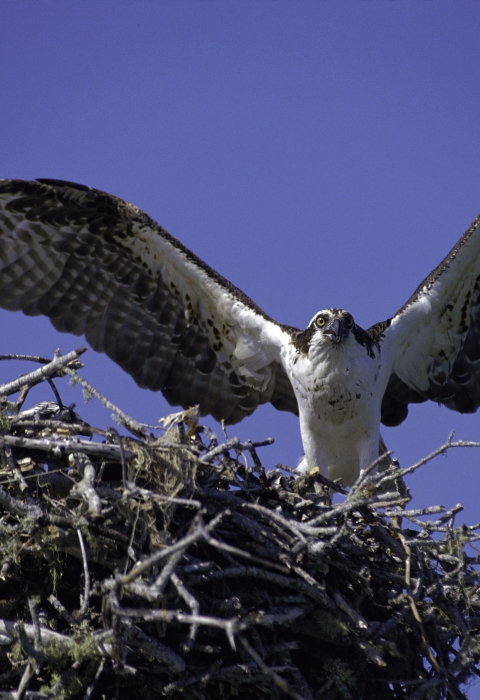Live streaming ‘nest cam’ featuring an active pair of ospreys in their nest at Waquoit Bay National Estuarine Research Reserve on Cape Cod. The nest cam provides wildlife enthusiasts an up-close and personal look at these amazing birds via a live video feed that is available for viewing at the Friends of Mashpee website.
“One of our goals as a community-based nonprofit is to give the public opportunities to enjoy and interact with nature and wildlife,” said Glenn Davis, President of the Friends of Mashpee National Wildlife Refuge. “...this osprey nest livestream will broaden our reach to all of Cape Cod and beyond. ...we are grateful for the opportunity to use the live nest cam for observation, research and education purposes.”
According to the Friends of Mashpee National Wildlife Refuge, ospreys, are also known as “fish hawks” due to their 99% fish diet – making Cape Cod a popular home. Easily recognizable by their brown and white coloring and intense yellow eyes, the birds arrive in March from wintering in Central and South America and don’t vacate their nests until it is time to fly south again in September. Mated Osprey pairs typically remain together for life – often returning to their previous nest and adding to it. They prefer to build their nests as high as possible to protect their eggs and offspring – typically one to four each season – and to gain a great vantage point for hunting. Livestream viewers can expect to see the birds soar overhead and return to the nest with fish to feed their family.
The live nest cam will also be incorporated into an exhibit at the Waquoit Bay Reserve Visitor Center. It will facilitate research and monitoring of the ospreys’ arrival dates, when their eggs are laid along with their incubation period, how frequent the birds are feeding and other behavior. Waquoit Bay National Estuarine Research Reserve Director Tonna-Marie Rogers remarked, “Reserve volunteers have monitored many nests over the years, however, this will be the first time we will be able to get an up-close look to learn more about the behavior of the birds. This is a great opportunity to educate people about these raptors with such strong ties to the estuary.”
About The Friends of Mashpee National Wildlife Refuge The Mashpee National Wildlife Refuge encompasses 5,871 acres and is the second largest accessible, open space on the Cape (the first being the National Seashore). Established in 1995, the Refuge Partnership is composed of eight conservation land-owners that form a unique type of management structure designed to protect and enhance the Refuge for people, wildlife, plants and fish. It was designed as a model for how future National Wildlife Refuges can be created and managed. The mission of the Friends of Mashpee National Wildlife Refuge is to ensure the long-term protection and enhancement of native wildlife and habitats, to support Mashpee National Wildlife Refuge Partners management efforts, and to promote advocacy, education, conservation, and recreational opportunities within the Mashpee Refuge.
About Waquoit Bay National Estuarine Research Reserve Waquoit Bay National Estuarine Research Reserve is part of NOAA’s national system of reserves designated for research, education, and stewardship and managed by the Department of Conservation and Recreation - Massachusetts State Park System.



